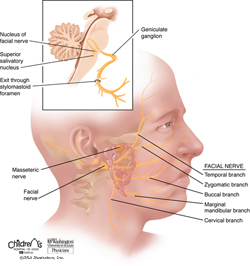
Why Does Facial Paralysis Occur?
There are many causes of facial paralysis (more than 100!). Facial paralysis occurs when there is loss of facial movement. The facial nerve, or cranial nerve VII, controls facial movement (facial expressions). The facial nerve travels from the brain, through the skull (the temporal bone), and then divides into 5 main branches (supplying the forehead, eye, cheek and nose, mouth, and neck) as it courses through the cheek to the facial muscles (see Figure A). Interruption anywhere along this pathway can result in facial paralysis.
Some causes of facial paralysis improve and even resolve spontaneously and some do not, some are present at birth and some occur later in life. Facial paralysis may be associated with other differences or syndromes or occur in isolation. Facial paralysis may be unilateral (affecting one side of the face) or bilateral (affecting both sides) and may affect people of all ages. Paralysis may involve the entire face or only a portion of it.
Causes of Facial Paralysis
| Cause | Description or Example |
| Congenital | Möbius syndrome, Vascular anomaly, Hemifacial microsomia, Goldenhar, Poland syndrome, Melkersson-Rosenthal, Other syndromes, No associated syndrome |
| Birth-related | Traumatic or difficult delivery |
| Bell's | Unknown cause, Viral infection |
| Traumatic Injury | Temporal bone fracture, Blunt force to cheek, Laceration, Swelling involving facial nerve |
| Infectious | Ear infections, Lyme disease, Viral infections (VZV (Ramsay Hunt), HSV, EBV), Mycoplasma, Mastoiditis |
| Neoplastic | Central, Parotid, or Acoustic tumors |
| Iatrogenic | Brain, Middle ear, and Facial surgery |
| Ischemic | Loss of blood supply to the nerve or muscle |
| Neurogenic | Guillan-Barré |
| Hematalogic | Leukemia, Hemophilia |
| Hypertension | High blood pressure |










